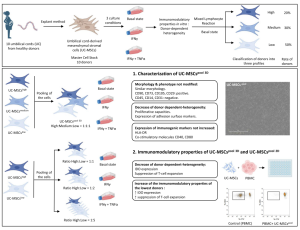Signals, Nov 9, 2023
by Kevin Robb
BlueRock Therapeutics has generated considerable media buzz with their announcement of positive Phase I clinical trial data on bemdaneprocel (BRT-DA01), an investigational, stem cell-derived, dopaminergic therapy for Parkinson’s disease. The trial is the result of decades of research and investments that yielded this exciting step into clinical translation.
Founded in 2016 by Versant Ventures and Bayer LEAPS, with scientific founders Drs. Lorenz Studer (Sloan Kettering Institute) and Gordon Keller (University Health Network), the mission of BlueRock Therapeutics is to discover and develop novel stem cell-derived therapies to improve treatments for patients. With the recent clinical trial, bemdaneprocel is the company’s most advanced product. Providing insights on the bench-to-bedside journey of bemdaneprocel, Dr. Stefan Irion (Chief Scientific Officer, BlueRock Therapeutics) presented an insider’s view on the investigational cell therapy at the 2023 Till & McCulloch Meetings.
Parkinson’s disease: Pathology and current treatments
Parkinson’s is a common neurodegenerative disease estimated to impact 100,000 Canadians and 10 million individuals globally. The condition is progressive and is associated with impairments to motor function, including tremor, rigidity, akinesia (i.e., loss of voluntary movement) and postural instability. Non-motor symptoms are also common, including mood disorders, cognitive impairments and sleep issues.
The pathology of Parkinson’s disease is linked to the death of neurons in the substantia nigra pars compacta. In this region of the brain, a protein known as alpha-synuclein becomes misfolded, forming plaques called Lewy bodies that contribute to the cell damage. The substantia nigra pars compacta contains an abundance of neurons that express dopamine – a critical neurotransmitter involved in signalling to other regions of the brain.
There is no cure for Parkinson’s and the first line of treatment involves administration of the dopamine precursor, L-DOPA, in an effort to restore levels of the neurotransmitter. However, as the disease progresses, L-DOPA becomes less effective and in some cases is entirely inadequate. Surgical interventions like deep-brain stimulation represent another option, but some patients remain resistant to the treatment. Thus, cell therapies represent an attractive line of research, offering the potential for life-long treatment with administration of living cells to replace the dopamine-expressing neurons damaged by the disease.
Cell therapies for Parkinson’s disease: Early trials
As recapped by Irion, cell therapies for Parkinson’s disease began to emerge in clinical trials in the late 1990s and early 2000s. In these early trials, several different dopamine-expressing cell types were explored, including retinal pigmented epithelial cells, autologous carotid body cells, adrenal medullary cells and fetal cells. With the exception of the latter, trials involving these various cell types were largely unsuccessful.
Given their initial promise, investigations of fetal cell grafts into the brains of patients with Parkinson’s disease led to two large placebo-controlled trials, but these ultimately failed to demonstrate efficacy. Nonetheless, the human trials provided useful insights including case study reports of patient autopsies demonstrating that the fetal cell graft could survive and integrate with the endogenous neural circuitry, persisting up to 24 years after transplantation.
The fetal cell approach was marked by several limitations, including a limited supply of cells and substantial heterogeneity of the cell population that may have compromised efficacy. As such, research turned to pluripotent stem cells as a potential source of renewable cells that could provide a consistent, scalable, and more refined source for generating dopamine-expressing neurons. In parallel, a global consortium called G-Force PD was formed in 2014 by leaders in the field, including Studer, the eventual scientific cofounder of BlueRock Therapeutics. The purpose of the consortium was to gather consensus and inform the intelligent design of a next wave of clinical trials involving stem cell-derived neurons for Parkinson’s disease treatment.
Preclinical development of bemdaneprocel
The Studer lab had long been interested in stem cells and Parkinson’s disease research. In 2011, the lab published a ground-breaking Nature paper detailing the controlled generation of midbrain dopaminergic neurons from human embryonic stem cells. This study provided an important foundation and led to millions in grant funding to develop the cell therapy for clinical trials. To do so, the team needed to adapt the protocol to make it more efficient and scalable, landing on a biphasic Wnt signaling pathway activation strategy for producing clinical-grade dopaminergic neurons that they reported a decade after the seminal Nature paper.
Using the new differentiation protocol, the Studer lab performed extensive preclinical testing of bemdaneprocel, publishing their findings in a Cell Stem Cell paper in 2021. These studies included the identification of a panel of differentiation markers measured by PCR that could be used to validate the phenotype of the cell product and ensure stability after cryopreservation and passing through a delivery device. Using a mouse model, the group performed biodistribution, toxicity, and tumourigenicity studies to demonstrate safety of the treatment.
In the same issue, the authors reported results of efficacy testing in a rat model for Parkinson’s. A critical aspect of this work involved behavioural testing of the rats in which the animals are treated with amphetamine and placed in a hemispherical bowl. Rats with a deficiency in dopamine-expressing neurons will turn in circles due to motor impairments, and these rotations can be easily quantified. Using this tool, the Studer group showed that rats implanted with bemdaneprocel displayed correction of the rotational bias compared to control rats, providing important evidence for their functional recovery.
With these promising preclinical safety and efficacy data, BlueRock Therapeutics initiated plans for clinical trials in humans. Drawing upon previous work in fetal cell clinical trials as well as the rodent studies, the investigators determined estimates for the dose of bemdaneprocel that would be needed for treating human patients with Parkinson’s disease.
Phase I clinical trial
Using the body of preclinical data, BlueRock Therapeutics received approvals from Health Canada and the U.S. Food and Drug Administration to conduct a phase I clinical trial. Beginning in 2021, the trial sites included Toronto Western Hospital, University of California Irvine, Weill Cornell Medical College, and Memorial Sloan Kettering Cancer Center. The open-label trial enrolled 12 patients, with the first five patients receiving a low dose of bemdaneprocel (1.8 million cells), and the subsequent patients treated with the high dose (5.4 million cells). A novel surgical technique and device were also developed to precisely implant the cells into the brain via a single burr hole through the skull. The patients will be followed for two years, and Irion presented the one-year interim results that have now been collected for the full cohort.
The patients enrolled in the study were an average of 66 years of age at the time of treatment and displayed moderate to advanced stages of Parkinson’s disease. They received immunosuppression for one year after treatment to allow time for the blood-brain barrier to heal from the initial surgery so that it could protect the implanted cells from immune recognition thereafter.
The primary goal of the trial is to evaluate safety and tolerability, and as reported in an earlier press release, no serious adverse events related to the cell therapy have been observed. The reported side effects have been minor or moderate and related to the immunosuppression regimen. At the time of Irion’s presentation, no patients had withdrawn from the study.
While efficacy data need to be interpreted with caution given that the study is a small open-label trial with risk of placebo effects, clinical scoring systems suggest that patients have improved, particularly those within the high-dose cohort. In addition, positron emission tomography (PET) imaging was performed in patients to measure uptake of a synthetic dopamine analogue and radiotracer to visualize regions of the brain containing dopaminergic neurons. These measurements revealed that the implanted cells survived and persisted at one year follow-up, with engraftment in the expected brain region.
In light of this encouraging data, BlueRock Therapeutics has announced plans to begin enrolling patients for a Phase II clinical trial within the first half of 2024. The study will provide new insights on the efficacy of the bemdaneprocel for patients with Parkinson’s disease.
Source: Signals








